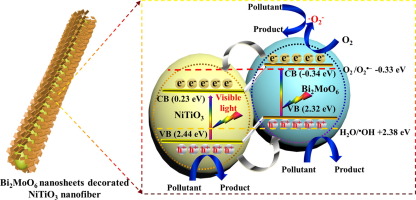Journal of Colloid and Interface Science ( IF 9.9 ) Pub Date : 2018-03-13 , DOI: 10.1016/j.jcis.2018.03.033 Shijie Li , Shiwei Hu , Wei Jiang , Yanping Liu , Yingtang Zhou , Yu Liu , Liuye Mo

|
A huge challenge in the field of pollutant removal is the scarcity of visible-light-driven (VLD) photocatalysts that are efficient, stable, easily recyclable and capable of mineralizing organic pollutants. In this regard, a novel hierarchical architecture of Bi2MoO6 nanosheets onto NiTiO3 nanofibers for tetracycline hydrochloride (TC) removal was rationally designed and fabricated via a facile approach. In this heterojunction system, highly homogeneous-distributed Bi2MoO6 nanosheets were anchored on electrospun NiTiO3 nanofibers, endowing the heterojunction with compact interfacial contact. By virtue of the favorable interfacial contact and matched band alignment, promoted suppression of photo-generated electron-hole recombination is achieved in Bi2MoO6/NiTiO3 system, as confirmed by photoluminescence measurement. As a result, the heterojunction with Bi2MoO6/NiTiO3 molar ratio of 1:1 exhibits an outstanding VLD photocatalytic activity and good stability for tetracycline hydrochloride (TC) degradation. The photodegradation rate constant (k) is 26.0, 5.4 or 3.7 folds higher than that of pristine NiTiO3, Bi2MoO6, or the mechanical mixture (20.2 wt% NiTiO3 + 79.8 wt% Bi2MoO6). The holes and superoxide radicals are detected as the dominant active species responsible for TC removal. Moreover, this work reports an efficient VLD photocatalyst for TC removal and will open up new insights into the design of novel fiber-shaped VLD heterojunction photocatalyts for environment remediation.
中文翻译:

钛酸镍纳米纤维上钼酸铋铋纳米片的层级结构:轻松合成和高效光催化去除盐酸四环素
污染物去除领域的巨大挑战是缺乏高效,稳定,易于回收且能够使有机污染物矿化的可见光驱动(VLD)光催化剂。在这方面,通过一种简便的方法合理地设计和制造了一种新型的Bi 2 MoO 6纳米片到NiTiO 3纳米纤维上的新型分层体系,用于去除盐酸四环素(TC)。在该异质结系统中,高度均匀分布的Bi 2 MoO 6纳米片被固定在电纺NiTiO 3上纳米纤维,使异质结具有紧密的界面接触。通过良好的界面接触和匹配的能带排列,如通过光致发光测量所证实的,在Bi 2 MoO 6 / NiTiO 3体系中实现了对光生电子-空穴复合的促进抑制。结果,Bi 2 MoO 6 / NiTiO 3摩尔比为1:1的异质结具有出色的VLD光催化活性,并且对四环素盐酸盐(TC)的降解具有良好的稳定性。光降解速率常数(k)比原始NiTiO 3,Bi 2 MoO高26.0倍,5.4倍或3.7倍6或机械混合物(20.2 wt%的NiTiO 3 + 79.8 wt%的Bi 2 MoO 6)。空穴和超氧化物自由基被检测为负责TC去除的主要活性物质。此外,这项工作报告了一种用于去除TC的高效VLD光催化剂,并将为新型的用于环境修复的纤维状VLD异质结光催化剂的设计开辟新的见解。



























 京公网安备 11010802027423号
京公网安备 11010802027423号